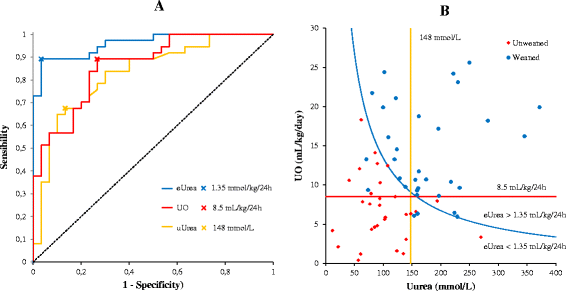Daily urinary urea excretion to guide intermittent hemodialysis weaning in critically ill patients
- PMID: 26895760
- PMCID: PMC4761179
- DOI: 10.1186/s13054-016-1225-5
Daily urinary urea excretion to guide intermittent hemodialysis weaning in critically ill patients
Abstract
Background: There are no easily available markers of renal recovery to guide intermittent hemodialysis (IHD) weaning. The aim of this study was to identify markers for IHD weaning in critically ill patients with acute kidney injury (AKI).
Methods: We performed a retrospective single-center cohort study of patients treated with IHD for at least 7 days and four dialysis sessions for AKI between 2006 and 2011 in an intensive care unit (ICU) of a French university hospital. Blood and urinary markers were recorded on the day of the last IHD in the ICU for unweaned patients and 2 days after the last IHD for weaned patients. Factors associated with IHD weaning were identified by multiple logistic regression. The areas under the receiver operating characteristic curve (AUROC) and the characteristics of the best diagnostic thresholds were compared.
Results: Sixty-seven patients were analyzed, including thirty-seven IHD-weaned patients. Urine output [odds ratio (OR) 1.59, 95% confidence interval (CI) 1.20-2.10 (per ml/kg/24 h increase); P = 0.01] and urinary urea concentration [OR 1.29, 95% CI 1.01-1.64 (per 10 mmol/L increase); P = 0.04] were both associated with IHD weaning. The optimal diagnostic thresholds for IHD weaning were urine output greater than 8.5 ml/kg/24 h, urinary urea concentration greater than 148 mmol/L, and daily urea excretion greater than 1.35 mmol/kg/24 h, with accuracy of 82.1%, 76.1%, and 92.5% (P = 0.03), respectively. The AUROC of daily urinary urea excretion (0.96) was greater than the AUROC of urine output (0.86) or the AUROC of urinary urea concentration (0.83) (P < 0.001).
Conclusions: A daily urinary urea excretion greater than 1.35 mmol/kg/24 h was found to be the best marker for weaning ICU patients with AKI from IHD.
Figures


References
-
- van de Wetering J, Westendorp RG, van der Hoeven JG, Stolk B, Feuth JD, Chang PC. Heparin use in continuous renal replacement procedures: the struggle between filter coagulation and patient hemorrhage. J Am Soc Nephrol. 1996;7(1):145–150. - PubMed
-
- Roberts DM, Roberts JA, Roberts MS, Liu X, Nair P, Cole L, et al. Variability of antibiotic concentrations in critically ill patients receiving continuous renal replacement therapy: a multicentre pharmacokinetic study. Crit Care Med. 2012;40(5):1523–1528. doi: 10.1097/CCM.0b013e318241e553. - DOI - PubMed
-
- Hoste EA, Blot SI, Lameire NH, Vanholder RC, De Bacquer D, Colardyn FA. Effect of nosocomial bloodstream infection on the outcome of critically ill patients with acute renal failure treated with renal replacement therapy. J Am Soc Nephrol. 2004;15(2):454–462. doi: 10.1097/01.ASN.0000110182.14608.0C. - DOI - PubMed
MeSH terms
Substances
LinkOut - more resources
Full Text Sources
Other Literature Sources
Medical

